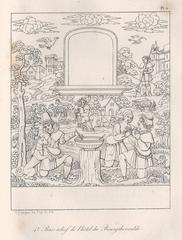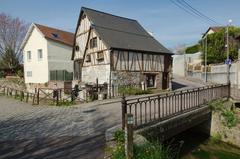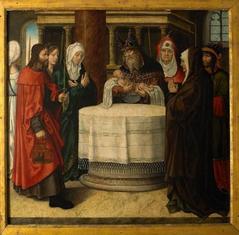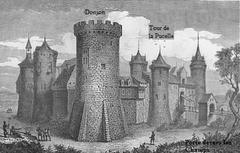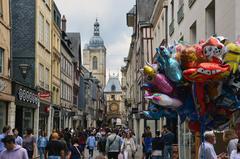
Avenue du Mont-Riboudet, Rouen, France: Visiting Hours, Tickets, and Historical Sites Guide
Date: 04/07/2025
Introduction
Avenue du Mont-Riboudet, located on the south shore of the Seine River in Rouen, France, exemplifies the city’s industrial heritage and its transformation into a dynamic urban corridor. Historically a center for coal, petroleum, and chemical industries, it now features automobile dealerships, commercial spaces, and innovative urban redevelopment projects. Its strategic location near port activity and railways has long contributed to Rouen’s economic growth, while ongoing regeneration projects like “Le 116” signal a future rooted in sustainability and community.
Visitors to Avenue du Mont-Riboudet can expect a blend of historic remnants, commercial vitality, and access to cultural venues such as the Palais des Sports. Comprehensive public transport, cycling infrastructure, and parking facilities make it an excellent starting point for exploring Rouen’s historic center, the Seine riverbanks, and major attractions including the Rouen Cathedral and the Musée des Beaux-Arts. This guide offers an in-depth look at the avenue’s history, visitor information, notable sites, nearby attractions, and practical tips for travelers. For the latest updates, visit the Rouen Tourist Office website or read more about the avenue’s heritage (source).
Table of Contents
- Avenue du Mont-Riboudet: Industrial Heritage and Modern Transformation
- Early Development and Industrialization
- The Name “Mont-Riboudet”: Origins and Evolution
- Changing Landscapes and Urban Growth
- Economic Importance: Industry to Commerce
- Modern Developments and Urban Renewal
- Visiting Information
- Historical Landmarks and Urban Memory
- Key Sites on Avenue du Mont-Riboudet
- Palais des Sports: Guide and Access
- Visitor Tips and FAQ
- Conclusion
- References
Avenue du Mont-Riboudet: Industrial Heritage and Modern Transformation
Avenue du Mont-Riboudet is a testament to Rouen’s ability to adapt and evolve. Once an industrial artery bustling with trade and manufacturing, today it is an urban corridor defined by its commercial energy, cultural venues, and integration into Rouen’s sustainable city planning. The avenue’s history and its ongoing developments reflect the city’s broader narrative of resilience and innovation.
Early Development and Industrialization
The origins of Avenue du Mont-Riboudet are closely linked to Rouen’s industrial expansion in the 19th and 20th centuries. The avenue emerged as a hub for coal imports—particularly under the influence of industrialist François Depeaux—and soon attracted petroleum refineries, sawmills, and chemical plants. Its proximity to the Seine and railway lines made it a critical node for logistics and trade (source).
The Name “Mont-Riboudet”: Origins and Evolution
“Mont-Riboudet” refers to a nearby hill that once separated Rouen’s center from Mont-Saint-Aignan. The name first appeared in the 1850s, with earlier variations such as “Triboudet.” While the exact origin of the name is uncertain—some suggest a former landowner’s name—its historical resonance is clear. The area was significant even in medieval times, as evidenced by the 933 AD military encampment and subsequent local place names (source).
Changing Landscapes and Urban Growth
Avenue du Mont-Riboudet’s landscape has been notably shaped by human intervention. The southern section once included the Île du Petit Guay, which was leveled in the 19th century to improve river navigation and accommodate urban expansion. This engineering effort fundamentally realigned the area, merging the island with the mainland and creating new urban opportunities (source).
Economic Importance: Industry to Commerce
Throughout the late 19th and early 20th centuries, Mont-Riboudet stood at the heart of Rouen’s industrial boom. Factories, depots, and chemical plants dominated the area, leveraging the river and railway for transport. By the 1920s, the district began transitioning towards commerce, becoming a center for Rouen’s automobile trade and, later, for residential and office developments (source).
Modern Developments and Urban Renewal
Today, Avenue du Mont-Riboudet is defined by its commercial vitality and is a focus for urban regeneration. The “Le 116” project is transforming a former dealership site into a mixed-use complex featuring residential, commercial, and green spaces, with completion expected in 2026. This and other initiatives underscore Rouen’s commitment to sustainable, people-focused city planning.
Visiting Information
Hours and Access
- Avenue du Mont-Riboudet: Open 24/7 as a public thoroughfare.
- Shops/Dealerships/Services: Typically open Monday to Saturday, 9:00 AM–7:00 PM.
- Cultural Venues: Hours vary; check individual listings.
Transportation and Accessibility
- Public Transport: Served by TEOR rapid transit (T1, T2, T3), several bus lines, and soon the T5 BHNS line (from autumn 2025).
- Cycling: Dedicated 3-meter-wide bike lanes connect to the regional Express Vélo Network and the Seine à Vélo route.
- Parking: The Mont-Riboudet P+R offers 874 spaces, with free parking during Palais des Sports events.
- Accessibility: Wide sidewalks, accessible crossings, and dedicated parking for people with reduced mobility.
Nearby Attractions
- Rouen Cathedral (Rouen Tourism): Gothic masterpiece, 15–20 minutes on foot or by TEOR.
- Musée des Beaux-Arts (Rouen Tourism): Renowned art collections.
- Vieux Rouen: Medieval streets, timber-framed houses, and monumental heritage.
- Gros-Horloge: Iconic astronomical clock.
- Place du Vieux-Marché: Historic market square.
- Docks 76: Shopping, dining, cinema in converted warehouses.
- Musée Maritime, Fluvial et Portuaire: Maritime heritage museum.
Events and Tours
- Guided Tours: Offered occasionally by Rouen’s tourism office, especially during festivals and special city events.
- Seasonal Events: Major city festivals may include activities or tours passing through the avenue.
- Palais des Sports Events: Concerts, sports, and exhibitions; event parking and tickets available through the venue and tourism office.
Photography Spots
- Modern and historic architecture along the avenue.
- Panoramic views of the Seine.
- Urban regeneration sites such as “Le 116.”
- The Mont-Riboudet transport hub and Docks 76.
Historical Landmarks and Urban Memory
While much of the avenue’s industrial infrastructure has disappeared, echoes of its past remain in warehouse facades, street layouts, and local stories. The transformation of Île du Petit Guay and the avenue’s historic role in Rouen’s resilience—surviving wartime bombings and postwar redevelopment—add depth to its urban memory.
Key Sites on Avenue du Mont-Riboudet
CIRFA Marine Rouen
- Location: 112 Avenue du Mont Riboudet
- Role: French Navy’s regional recruitment and information center. Occasionally hosts public events.
Mont-Riboudet Transport Hub
- Features: Dedicated TEOR lanes, three stations, and a large parking facility. Key node for city and regional transit.
Palais des Sports: Guide and Access
Historical and Cultural Significance
Opened in 1977, the Palais des Sports is a major cultural and sporting venue on the avenue. It hosts international basketball games, concerts, and trade fairs, and is notable for its modernist architecture and community role.
Visiting Hours and Tickets
- Hours: Vary by event; check the Rouen Tourism or venue website.
- Tickets: Available online, at the venue, and at authorized sales points.
Accessibility and Transport
- Public Transport: TEOR lines T1, T2, and T3; additional bus routes; future T5 line.
- Parking: Mont-Riboudet P+R (free for event attendees during specific hours).
- Cycling and Walking: Safe bike lanes and pedestrian paths.
- Accessibility: Low-floor buses, ramps, and designated PMR parking.
Visitor Tips and FAQ
Tips
- Free Public Transport: The Astuce network is free on Saturdays (ticket validation required).
- Best Visiting Times: Spring and summer for outdoor exploration; weekdays for quieter walks.
- Bike Rentals: Available near the city center and train stations.
- Stay Updated: Check official websites for transport changes due to construction.
FAQ
Q: Is Avenue du Mont-Riboudet a historic monument?
A: No, but it is significant for its urban and industrial heritage.
Q: Are there entrance fees?
A: No, the avenue is a public space; only specific attractions or events may charge fees.
Q: Can I join guided tours?
A: Yes, occasionally through the tourism office, especially during festivals or themed city tours.
Q: Is parking available?
A: Yes, with ample spaces at Mont-Riboudet P+R, including for people with reduced mobility.
Q: How do I get to the Palais des Sports?
A: By TEOR lines T1-T3, multiple bus routes, or by car with event parking available.
Conclusion
Avenue du Mont-Riboudet encapsulates Rouen’s industrial roots and urban renewal, offering visitors a unique perspective on the city’s evolution. With its accessible location, excellent transport connections, and proximity to major cultural landmarks, the avenue is both a destination in itself and a gateway to Rouen’s rich historical and contemporary life.
For real-time updates, tour bookings, and event information, visit the official Rouen Tourist Office website. Enhance your visit by downloading the Audiala mobile app for maps, audio guides, and notifications about the latest events. Follow us on social media for ongoing tips and insider recommendations.
References
- Avenue du Mont-Riboudet: A Historical and Visitor’s Guide to Rouen’s Industrial Heartland, Actu.fr
- Discover Avenue du Mont-Riboudet in Rouen: Urban Heritage and Visitor Guide, Rouen Tourism
- Exploring Avenue du Mont-Riboudet in Rouen: History, Visitor Info & Nearby Attractions, Rouen Tourism
- Visiting the Palais des Sports on Avenue du Mont-Riboudet: Accessibility, Transport, and Visitor Information, Rouen Tourism


